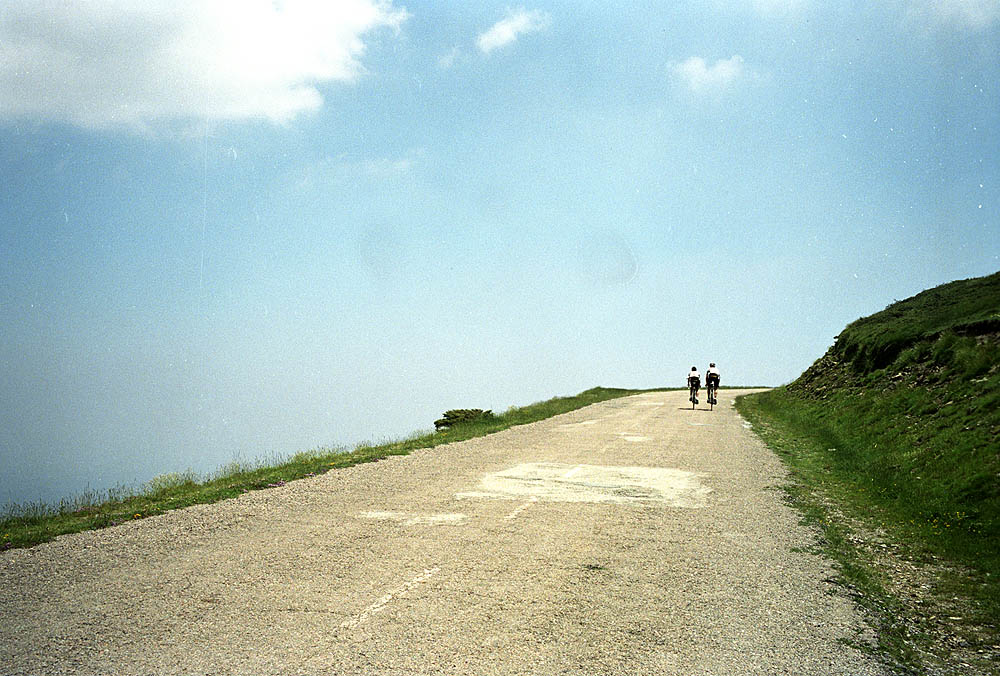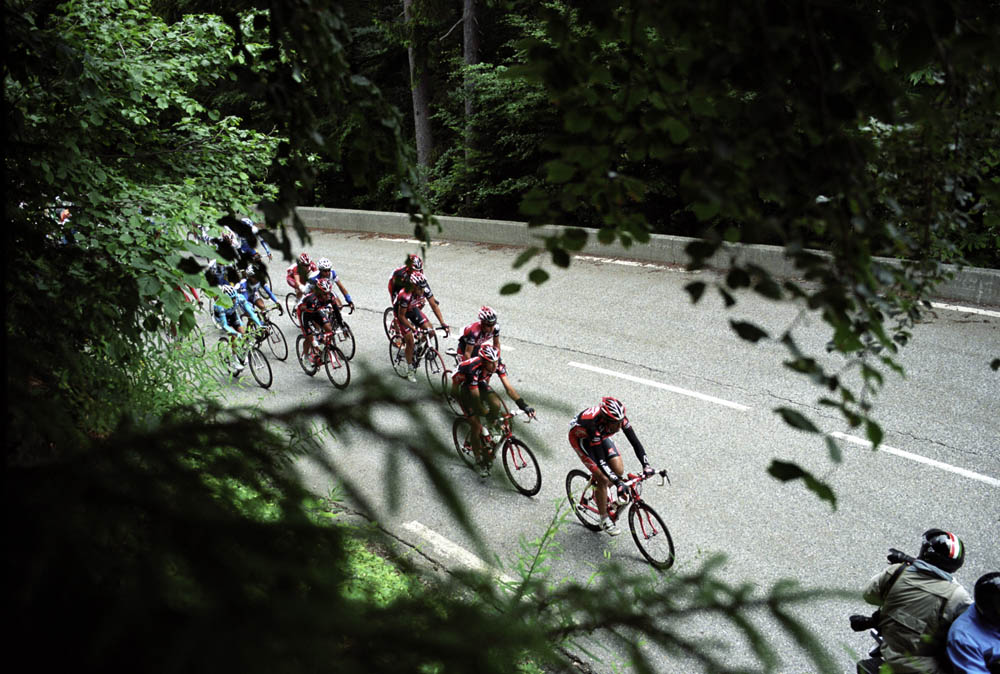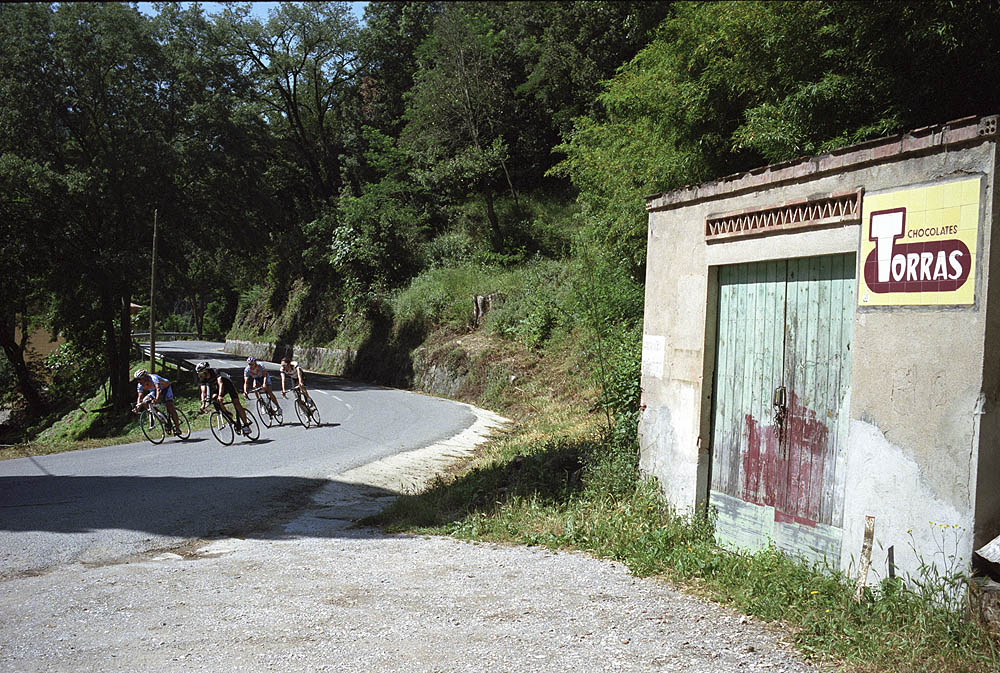By Michael Barry
Photography by Camille McMillan
Into the sixth hour of the ride, the temperature drops as I reach the top of the Pyrenean peak. Autumn is arriving on the mountain slopes and the sun that burned the plains has lost its strength in the late afternoon. My shadow is long and lone on the tarmac. A ribbon of road, open and without traffic, laces its way up the treeless mountain side in front of me. A crystal mountain stream trickles. Wind blows the tall grass. Cattle graze on a steep slope. Distant sounds echo in the slight wind and I occasionally hear the clangs of their bells when the breeze brushes my cheek. My breath and the ticking of my chain are the only other noises.
The mountain air is liberating after the claustrophobia of the hot valley road. Anxious truck drivers shipping goods to northern Europe and cars of tourists racing home from vacation honk with impatience. I stick to the edge of the two-lane valley road counting every kilometer. Now, on the mountain, the meters pass unnoticed.
Stepping out of the saddle I re-launch my bike to maintain the fluidity I found in the first kilometers of the long ascent. I am in flight as I climb towards the sky. Settling in the saddle again my breath is in synch with my pedal stroke and each movement is subconsciously part of the rhythm I create. I shift gears with changing gradients and readjust my position on the bike to preserve the punch of the pedal stroke.
Near the summit, the names of cyclists that were painted on the road have worn away with time. They tell the story of a race and mark a generation. Heras, Mancebo, Ullrich. Their names are fading like their results. Years ago, they stormed the climb in front of tens of thousands of fervent fans who had crossed the continent to see them ascend. Like ghosts their names now haunt cycling; they inspired with their heroics on the bike and disappointed when those performances were proven to be drug-enhanced. But their inhuman performances still endure. Stories of their elegant force are forever told.
A climb simplifies cycling as the variables that make racing tactical are eliminated. Speeds are lower and drafting is no longer a great factor. The strongest riders surge ahead, paring the numbers and clarifying the tactical battle. The less the rider carries, the quicker he rides. Some look to shave off weight in everything they carry: their bodies, their shoes, their bikes and their clothing. They cut away excess material, count grams of body weight instead of kilograms, and strip their bicycles of computers and bottle cages. As overall weight decreases, watts per kilo increase along with the speed. Lean, gaunt, and elf like, a man on a bicycle can ascend like a bird in flight. Federico Bahamontes, the Spanish climbing ace of the 1950s and 60s, was nicknamed the Eagle of Toledo for his ability to soar in the mountains. Cyclists who are en forme can look ill when compared to an average human – we become gaunt with hollowed cheeks, our ribs protrude as muscle and fat have been stripped from our upper bodies, and flushed veins run across the skin’s surface. The French say, “Un homme en forme est un homme malade.” A cyclist at his peak is a sick cyclist. Not because he is unhealthy but because his body has been pushed to the limit. Like a Formula One car that can fly on a racetrack but can’t cope with a bump in the road, our bodies are so specialized they are useless off the bike.
Alone, as I near the Pyrenean peak, I feel fast. The only person I race against is myself, and the ghosts that I create. I throttle towards the summit, accelerating hard out of the tight switchbacks and glancing at the road ahead while focusing on the peak above. The kilometer markers posted at the roadside seem to come every couple of minutes. I don’t need to look at my powermeter to know I am fit. The data it stores will be all that records my effort. With nobody to judge me or compete against me, and no spectators to witness the effort, this is a solitary experience race I create. It is only the race that will invoke a rare emotion. I can see my imagined finish line at the top.
There, I will stop. I’ll look down on the valley below, at the road I have just ascended, and at the peaks around me. I will sip from my bottle. I will pull on my jacket. I will be alone. A few cows will chew on grass near the roadside – they’ll glance up as I near them and then bow towards the grass, continuing to eat. Beside them, a stone monument tells the story of the mountain or a saint. I will zip up my jacket, climb on my bike, and begin the long descent. I feel free but never alone.
The bike glides through the corners. I tap my brakes minimally while using my body weight to carve through the turn. Without a car in sight I use every meter of the road. Every centimeter. The switchbacks that lace up the mountain pass become a playground, like the city streets of Toronto and the thick traffic were for me as a kid. The dangers are there, but in the moment I am not conscious of them; I feel completely in control and able to find the line and the limit.
As I accelerate out of a corner and into a steep straightaway, the bike takes off. Unable to pedal fast enough, I tuck my body low on the bike and I sense the surge as it accelerates again with the decrease in drag. My eyes water beneath my glasses with the cool blast of air. My face is close to my handlebars and my chest rests on the bicycle’s stem. As I near another corner I rise out of the position, which slows me like parachute does a dragster. In minutes I have descended a mountain that has taken me an hour to climb.
The maximum speed on the speedometer reads 96 km/h. The small tires and super light carbon bike carry me comfortably – in the moment, I rarely question their strength or think of them failing as to do so would indeed be my failure. Like a mountain climber trusts in the quality of his ropes, we become accustomed to the best equipment; the climber could never ascend a rock face to its peak without confidence in the material, as fear would consume his consciousness if he did.
As I reach the valley, the sounds of the surrounding environment return as the wind that had whistled into my ears as I descended abates. Like a child shutting down a video game and picking up a book, everything slows: my heart rate, my bike and my mind. I find another rhythm on the flat valley roads. Daydreams enter my thoughts. The thoughts jump around until they land on the World Championships, which are just over a month away. My season is almost over and my form is honed. The eighty days that I’ve already raced this season have given me a level of fitness and resilience unachievable in training. But the wear of the travel, the time away from home, and the pressure to perform is mentally draining.
Fallen leaves whip across the mountain road as the sun sits low on the horizon. The distance I have ridden has become incidental as I am accustomed to full days on my bike. There is an ache in my legs from the effort but the pain I felt in the spring after a long ride – the near disability of it – is absent. I have just flown up and over a mountain. I am high. But I also sense that it is time to find another routine again. My body and mind need a rest.
The time on the bike, at the races, and away from home create a challenge for most cyclists. We become distant from our families and the routines at home are broken, quickly becoming unfamiliar as the season wears on. During the year, we spend more time with our teammates than our children. In the autumn, the wear of our punishing season is clear.
The autumn pelotons strike a contrast to those at the early season Classics. During the last races of the year, the fatigue of the long season is evident: teams have difficulty fielding full squads due to illness, injury and lack of motivation, and it seems many riders just go through the motions, to do their jobs and finish off the year. The riders who are motivated are those without future contracts or those who have planned their year to peak for the finale. The cycling calendar is unbalanced as most teams start with a bang in the hopes of securing sponsors, race entries and media attention. They finish the year simply because they must. With good form and motivation, a rider and his team could perform tremendously in beautiful and prestigious races at the end of the year, if only they timed their peak fitness a little better. But in the end, cycling is a business and money is the priority.
During the second half of the season the same complacency, or weariness, is evident in the way the peloton races. In the spring, every rider is eager to be at the front, animating the race, to show their face and to achieve results. The races aren’t faster than those in the late summer but there is greater depth in the peloton. In the autumn, many riders start races under their team’s orders and give in as soon as they reach the slightest difficulty, while in the spring those same riders chase back after crashing, covered in blood, because they still believe.
Lost in my daydreams I ride the final kilometers of the route without taking notice of the surroundings until I reach the outskirts of the small mountain town and see the town sign in the distance. I readjust my position for one more fight. This time I sit low, kicking back in the saddle while gripping the drops of the handlebars tightly. Again, I create my own race. A car passes. As if the sign were my finish line, I step out of the saddle, gauging my effort on the distance to the sign, and launch myself into a sprint, hammering the pedals. The bike thrashes from side to side beneath me. The effort is fierce. I imagine a competitor on my right and reaccelerate, surging, thrusting, and driving my body and the bike. I give out, I give in, as I reach the imaginary line at the town sign.
Days later, I am in an airport on my way to the final stage race of the season. Panicked travelers rush, sweat, curse and fret around me. Comfortable in the routine I wait, find my place, listen to music, and watch the shuffle of bags, the bumps of bodies, and the flash of faces as they pass through the terminal in haste. Planes roar away while others roll up. The excitement of travel has become mundane with repetition.
At the other end, in another terminal in another country, a soigneur patiently waits for me to arrive. He has driven for an hour from the hotel to be my chauffeur. During the drive we gossip about cycling – which riders are transferring to which teams, the results, the races, the difficulties and complaints. Within our bubble, we lose perspective: small abnormalities and complaints become amplified as they circulate, turning into an irritant. The soigneurs, like the mechanics, seem to be informed on everything within the team like a secretary who oversees an office.
Arriving at the hotel, the mechanics are working on the bikes under the spotlights of the team truck. The air compressor hums behind the din of electronic music. Dressed in blue work clothes, their hands covered in grease, they bop to the music as they shift through gears, pump tires, and screw on number plates. Three other team trucks are lined up beside them with mechanics at work.
Like the soigneurs, they know the importance of the race because many were professional cyclists, or amateurs, or simply keen fans. Cycling is still a foreign novelty to North Americans, but to Europeans it is part of their culture. The staff takes pride in their work because, on some level, they believe and understand that they are not only working on bikes; they are also a part of something greater – cultural history. That understanding, along with their work ethic and their discipline, turns their work from job to trade – they’re experts in the same way that a carpenter can manipulate wood to make something that is both beautiful and reliable. They work with passion.
From the seat of the team car I can see one of the mechanics, Chris, working on my bike. Bundled up in a heavy jacket and hat, he looks up from the task and smiles as we park. During the race I will trust his work and never question it. And he will sit confidently in the car behind, knowing that nothing will fail. He will recheck my bike one last time in the morning before the
start. The details make the difference.
During the race he will check the tubular rubber each evening for cuts and wear, and a worn tubular will be replaced. Each tire has been aged in a cellar – like a good wine they will, over time, reach their maturity where they become something unique with subtle differences in performance that a professional can feel. For each of his Tour de France victories, Armstrong rode special aged tires that no other riders on the team had. He rarely flatted and had few difficulties over the tens of thousands of kilometers raced.
My race bike is ready. It shines like a new bike from a shop. The transition from my training bike to a race bike is like chopping tomatoes with a worn kitchen knife and then switching to a high carbon steel chef ’s blade. The tubular tires glide and grip, the race wheels are stiff and smooth, and the bike is clean and crisp. Not only technically better, a race bike with aerodynamic light wheels also gives a psychological lift.
Purchase Le Metier: The Seasons Of A Professional Cyclist






